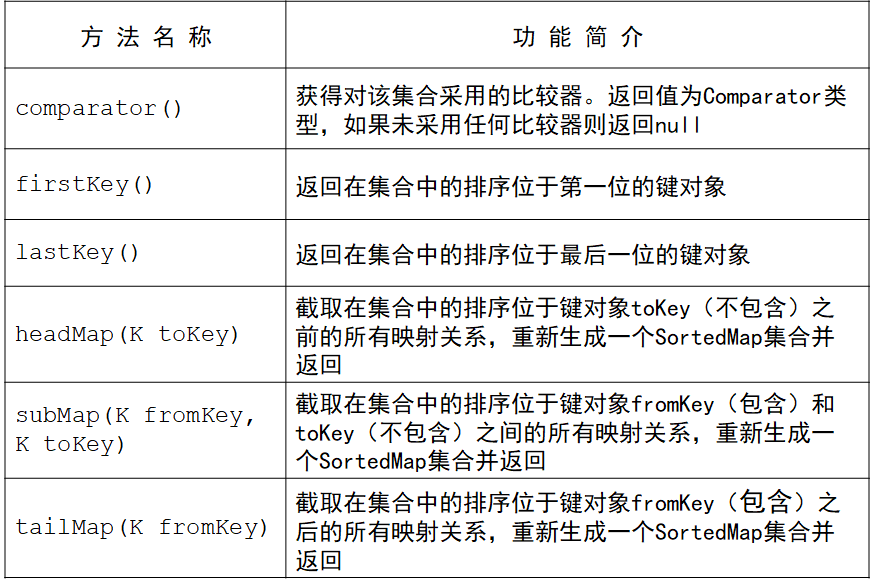Map接口作为Java集合框架中的第二类接口,其子接口为SortedMap接口,SortedMap接口的子接口为NavigableMap接口。
实现了Map接口具体类有:HashMap(子类LinkedHashMap)、TreeMap、EnumMap、WeakHashMap、IdentityHashMap。
1.HashMap
HashMap类实现了Map接口,由HashMap类实现的Map集合,允许以null作为键对象,但是因为键对象不可以重复,所以这样的键对象只能有一个。
如果经常需要添加、删除和定位映射关系,建议利用HashMap类实现Map集合,不过在遍历集合时,得到的映射关系是无序的。
☆在使用由HashMap类实现的Map集合时,需要重写作为主键对象类的HashCode方法。在重写hashCode方法时,有两条基本原则:
- 不唯一原则:不必为每个对象生成一个唯一的哈希码,只要通过hashCode方法生成的哈希码能够利用get方法得到利用put方法添加的映射关系即可。
- 分散原则:生成哈希码的算法应尽量使哈希码的值分散一些,不要很多哈希码值都集中在一个范围内,这样有利于提高由HashMap类实现的Map集合的性能。
☆在使用由HashMap类实现的Map集合时,也需要重写作为主键对象类的equals方法,该方法默认比较两个对象的地址,即使这两个键对象的内容完全相同,也不认为是同一个对象。
(1)新建一个Map集合对象
Map<PK_person, Person> map = new HashMap<>();
(2)使用Map类的put方法添加一个键/值对象
PK_person pk_person = new PK_person(); pk_person.setPrefix("MR"); pk_person.setNumber(13211041); map.put(pk_person, new Person("小一", pk_person));
(3)使用Map类的get方法通过键得到值对象
Person person = map.get(pk_person);
System.out.println(person.getName() + " " + person.getNumber().getPK());
(4)新建一个副本键对象,内容和前面的键对象完全一致,这里会打印“该键对象不存在”,这是因为虽然pk_person2和pk_person的内容完全一样,但是系统默认的equals方法比较的是两个对象的地址,而这两个对象的地址不一致,所以不认为是同一个对象。
PK_person pk_person2 = new PK_person(); pk_person2.setPrefix("MR"); pk_person2.setNumber(13211041); Person person2 = map.get(pk_person2); if (person2==null) { System.out.println("该键对象不存在"); } else { System.out.println(person2.getNumber().getPK()); }
(5)根据实际需求,如果两个键对象的内容完全一样,那么我们就应该认为这两个键对象一样,通过get方法应该能够得到映射的值对象,这个时候可以通过在键对象的类PK_person中重写hashCode方法和equals方法来解决。
这里将默认的hashCode方法重写,从而保证了只要是键对象的内容相等,它们的hashCode码就相等。
通过equals方法比较pk_person2和pk_person时,首先不是同一个实例、obj也不为空、是同一个类的实例,同时哈希码相等,于是判断出这两个键对象是相等的。
// 重写hashCode方法,返回的哈希码就是简单的int类型的number加上String类型的prefix对象的hashCode方法 @Override public int hashCode() { return number + prefix.hashCode(); } // 重写equals方法 @Override public boolean equals(Object obj) { if (this == obj) // 是否为同一个实例 return true; if (obj == null) // 是否null return false; if (getClass() != obj.getClass()) // 是否为同一个类的实例 return false; final PK_person other = (PK_person) obj; // 对应的哈希码是否相同 if (this.hashCode()!=other.hashCode()) return false; return true; }
然后再次运行上述程序,就可以得到对应的结果:
MR_13211041
完整代码:

package hashMap.jun.iplab; public class PK_person { private String prefix; private int number; public String getPrefix() { return prefix; } public void setPrefix(String prefix) { this.prefix = prefix; } public int getNumber() { return number; } public void setNumber(int number) { this.number = number; } public String getPK() { return this.prefix + "_" + this.number; } public void setPK(String pk) { int i = pk.indexOf("_"); this.prefix = pk.substring(0, i); this.number = new Integer(pk.substring(i)); } // 重写hashCode方法,返回的哈希码就是简单的int类型的number加上String类型的prefix对象的hashCode方法 @Override public int hashCode() { return number + prefix.hashCode(); } // 重写equals方法 @Override public boolean equals(Object obj) { if (this == obj) // 是否为同一个实例 return true; if (obj == null) // 是否null return false; if (getClass() != obj.getClass()) // 是否为同一个类的实例 return false; final PK_person other = (PK_person) obj; // 对应的哈希码是否相同 if (this.hashCode()!=other.hashCode()) return false; return true; } }

package hashMap.jun.iplab; public class Person { private String name; private PK_person number; public Person(String name, PK_person number) { super(); this.name = name; this.number = number; } public String getName() { return name; } public void setName(String name) { this.name = name; } public PK_person getNumber() { return number; } public void setNumber(PK_person number) { this.number = number; } }

package hashMap.jun.iplab; import java.util.HashMap; import java.util.Map; public class Test { public static void main(String[] args) { Map<PK_person, Person> map = new HashMap<>(); PK_person pk_person = new PK_person(); pk_person.setPrefix("MR"); pk_person.setNumber(13211041); map.put(pk_person, new Person("小一", pk_person)); // Person person = map.get(pk_person); // System.out.println(person.getName() + " " + person.getNumber().getPK()); PK_person pk_person2 = new PK_person(); pk_person2.setPrefix("MR"); pk_person2.setNumber(13211041); Person person2 = map.get(pk_person2); if (person2==null) { System.out.println("该键对象不存在"); } else { System.out.println(person2.getNumber().getPK()); } } }
2.TreeMap类
TreeMap类不仅实现了Map接口,还实现了Map接口的子接口SortedMap接口。
由TreeMap类实现的Map集合,不允许键对象为null,因为集合中的映射关系是根据键对象按照一定顺序排列的。
在添加、删除和定位映射关系上,TreeMap类要比HashMap类的性能差一些,但是其中的映射关系具有一定的顺序,如果不需要一个有序的集合,则建议使用HashMap类;如果需要进行有序的遍历输出,则建议使用TreeMap类。
通常的做法是:首先利用HashMap类实现一个Map集合并初始化,将元素添加到Map集合中,然后再利用TreeMap类实现一个TreeMap集合,在将原来的Map集合中的元素都添加到新的TreeMap集合中,在根据要求进行升序或者降序即可。
TreeMap由于实现了SortedMap接口而拥有的方法为:

(1)由HashMap类实现一个Map集合并将元素添加到Map集合中
Person person1 = new Person("小一", 13311123); Person person2 = new Person("小二", 13223131); Person person3 = new Person("小三", 13432412); Person person4 = new Person("小四", 13621312); Person person5 = new Person("小五", 13531231); Map<Number, Person> map = new HashMap<>(); map.put(person1.getId_card(), person1); map.put(person2.getId_card(), person2); map.put(person3.getId_card(), person3); map.put(person4.getId_card(), person4); map.put(person5.getId_card(), person5);
通过遍历查看此时Map集合中的元素的排列顺序,此时没有顺序:
Iterator<Number> it = map.keySet().iterator(); while (it.hasNext()) { Number number = (Number) it.next(); System.out.println(number); } 输出: 13432412 13531231 13223131 13311123 13621312
(2)创建一个TreeMap对象,然后将原来的map集合中的数据都添加到新建的treeMap集合中,然后使用默认的排序方式即键对象的升序(Person类实现了Comparator接口)顺序进行访问
TreeMap<Number, Person> treeMap = new TreeMap<>(); treeMap.putAll(map); Iterator<Number> it_1 = treeMap.keySet().iterator(); while (it_1.hasNext()) { Number number = (Number) it_1.next(); System.out.println(number); }
输出:
13223131
13311123
13432412
13531231
13621312
(3)新创建一个TreeMap对象,然后将原来的map集合中的数据都添加到新建的treeMap集合中,然后按照降序即反转顺序排序进行访问:
TreeMap<Number, Person> treeMap = new TreeMap<>(Collections.reverseOrder()); treeMap.putAll(map); Iterator<Number> it_1 = treeMap.keySet().iterator(); while (it_1.hasNext()) { Number number = (Number) it_1.next(); System.out.println(number); } 输出: 13621312 13531231 13432412 13311123 13223131
